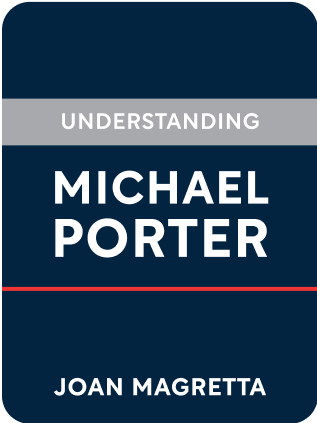

This article is an excerpt from the Shortform summary of "Understanding Michael Porter" by Joan Magretta. Shortform has the world's best summaries of books you should be reading.
Like this article? Sign up for a free trial here .
What is the five forces model? How can you use the five forces to conduct business analysis?
The five forces model is a model used in Understanding Michael Porter to break down why some businesses are profitable. The five forces model uses several key components of a business’s operations and its position within the industry.
How Does The Five Forces Model Work?
Why are some industries consistently more profitable than others? What makes information technology so stereotypically profitable, while airlines are a cutthroat, low-margin grind? The five forces model of competition can help explain this.
Force 1: Buyers
What this is:
- Customers who pay for your product
- Channels that influence the purchase decisions of end-users
- Retailers like Home Depot, Amazon
- Advisers like doctors, investment managers
What it does:
- Lowers prices, since powerful buyers will demand lower prices or else
- Increases costs, since powerful buyers demand more value or else
Scenarios in your advantage:
- If you’re large relative to buyers (i.e. buyers are fragmented)
- Truck maker Paccar appeals directly to individual owner-operators through comfort and customization, rather than brands like Peterbilt that appeal to large corporate buyers (more consolidated).
- High switching costs to your competitors
- Risk aversion dissuades buyers from trying new things.
- Habits get people accustomed to your product.
- Low switching costs to you
- Information asymmetry – inability to price compare, measure quality
Scenarios in your disadvantage:
- Price sensitivity by buyers. This is more likely when your industry’s products are:
- Undifferentiated
- Expensive relative to the buyer’s other costs
- Inconsequential to the buyer’s own performance
- Buyers are consolidated relative to you and competitors
Force 2: Suppliers
The second of the five forces model of competition is the threat of suppliers.
What this is:
- Providers of any direct input into your product
- Distribution channels, marketing
- Labor
What it does:
- Increases costs, since powerful suppliers can demand higher prices or else
Scenarios in your advantage:
- Your size relative to a supplier (higher % of supplier’s sales coming from you)
- (Shortform example: Groupon aggregated buyers to exert pricing power over small restaurants, yielding tremendous short-term success. Unfortunately, over time restaurants realized this was unprofitable and dropped out.)
- (Shortform example: the Internet brought marginal distribution cost to zero, allowing aggregators like Google and Facebook to amass consumer attention to exert control over information suppliers like media companies, eventually commoditizing them.)
- Low switching costs for you to change to alternate suppliers
- You can credibly threaten to vertically integrate into the supplier’s industry.
- Coca-Cola can threaten to produce its own cans.
- (Shortform example: Google produces its own phones to lower bargaining power of manufacturers who use Android.)
Scenarios in your disadvantage:
- Labor unions
- Unions consolidate labor into a forceful bloc, wielding large negotiating power with employers.
- In the airline industry, unions restricted who could be employed to wave planes back from gate, increasing costs for airports and airlines.
- When the industry needs suppliers more than suppliers need the industry
- In other words: when suppliers have many alternative buyers in other industries, or when your industry is a small fraction of sales for your suppliers.
- High switching costs for you to change suppliers
- The PC industry has been beholden to Microsoft, because the switching cost of its customers to another operating system is huge.
Force 3: Substitutes
What this is:
- Any product not directly in your industry that basically can do the same job as you
- Examples:
- For coffee as a caffeine vehicle, substitutes are energy drinks, tea.
- For food delivery, substitutes are eating in restaurants, microwaved food, and groceries.
- For human tax preparers, substitutes are TurboTax and doing it independently.
- OPEC has fended off substitutes by managing the price of oil to prevent prices from going so high that investment in oil alternatives becomes attractive.
What it does:
- Lowers prices to avoid buyers going to substitutes
- Increases costs, since incumbents compete with substitutes to provide superior value
Scenarios in your advantage:
- If you can offer a better price-to-performance ratio
- Note this does not mean that the lower price always wins. It’s a higher value for the same price, or same value for lower price, or variations thereof.
- Solving a segment’s problems better than alternatives
- A segment of buyers may hire human accountants to outsource complexity and time in preparing their own tax returns. For this segment, TurboTax is insufficient for their needs.
- High switching cost
Notes:
- Substitution has a cascading effect from upstream in the value chain that may be hard to predict.
- Say you’re a manufacturer of steel car bodies. The shift to electric cars may mean heavier batteries, so car manufacturers start looking to carbon fiber as a substitute for steel. Even though the change came outside your immediate industry of steel car bodies, your business is strongly affected.
Force 4: Rivalry Between Incumbents
What this is:
- Competition among you and your competitors
- Rivalry takes a variety of forms along the value chain: marketing, product features, new product introductions, customer service, pricing.
What it does:
- Lowers prices to attract customers away from competitors
- Increases costs, since incumbents compete on providing superior value
Scenarios in your advantage:
- High switching costs to competitors
- Low switching costs to you
- (Shortform example: Apple tries to make switching from Windows easier, while building a walled garden of products to make leaving harder)
Scenarios in your disadvantage:
- Fragmentation of industry
- A bevy of competitors all vying for market share will produce stronger competition. In contrast, an industry leader that’s big enough can enforce practices that help the entire industry.
- Low growth provokes battles over market share
- High exit barriers preventing companies from leaving the industry, thus keeping excess capacity around
- Failed airlines have airplanes that can be bought cheaply by an upstart
- Rivals irrationally committed to the business, outside of financial performance
- State-owned enterprises may exist for job creation and be subsidized by taxes.
- (Shortform example: Amazon seeks scale at the expense of profits, making it hard for any company that needs to produce a profit.)
- Competition based mostly on price. This can arise in these scenarios:
- Lack of differentiation between products, relying on price to attract customers
- High fixed costs and low marginal costs. This provokes the thinking that “any new customer will contribute to covering overhead,” thus encouraging lowering of prices.
- When capacity must be added in large increments, leading to price cutting to fill capacity
- When product is perishable. Not just food, but also unfilled hotel rooms and restaurant tables.
Force 5: New Entrants
What this is:
- New competitors, either upstarts or incumbents from other industries
- An industry can be attractive to incumbents, while being unattractive to new entrants because of entry barriers
What it does:
- Lowers prices, since higher prices attract newcomers to arrive and take profits
- Increases costs, since incumbents have to raise entry barriers
Scenarios in your advantage:
- Economies of scale
- This can take multiple forms: spreading fixed costs over large volume, bargaining power over suppliers, more efficient technologies at scale
- Large starting capital investment
- Proprietary information or IP
- Regulation
- Network effects of your product
- Branding, customer reputation as the “safe choice”
- High switching costs to alternative
- Existing relationships in the value chain (eg distribution partners)
- Retaliation against new entrants by incumbents
- This is stronger in industries with low growth or high fixed costs
The five forces model of competition can help you analyze a business strategy, and build your own strategy. Using the Five Forces model is a way to build a strong and competitive business.

———End of Preview———
Like what you just read? Read the rest of the world's best summary of Joan Magretta's "Understanding Michael Porter" at Shortform .
Here's what you'll find in our full Understanding Michael Porter summary :
- How Porter's famous Five Forces help you analyze every industry
- How IKEA, Southwest Airlines, and Zara have ironclad, defensible strategies
- Why the best companies reject opportunities to focus on what they know






